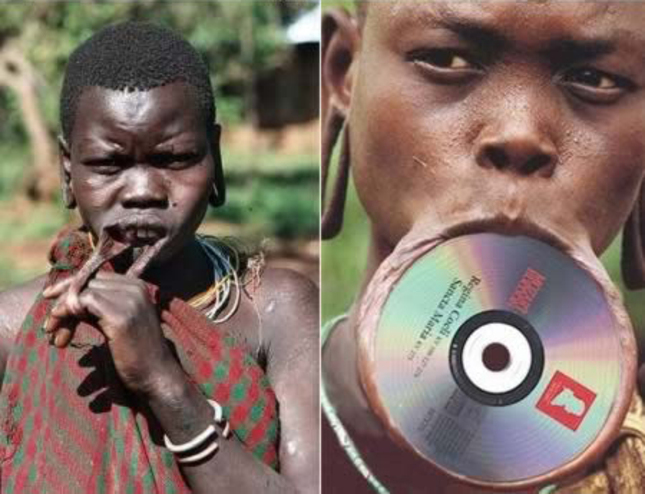While it’s hard to say for sure who first came up with the idea of ear elongation, or why, many cultures still maintain ear elongation today for a variety of reasons.

Sometimes it is a religion, a ritual of a ceremony, to ward off evil spirits or increase sexual hormones, some places even believe it is a traditional beauty of women, the longer the ear, the more beautiful.
Today, the Masai tribe in Kenya, or the Huarani tribe in the Amazon basin, the practice of ear lengthening is still very popular.

This is a picture of the Apatani tribe living in the Ziro valley in northeastern India. The women here are considered the most beautiful among the Arunachal tribes.
In fact, they have accepted to make themselves look strange and unattractive to protect themselves, in case of invasion by other tribes. Therefore, most of the women in Apanti stick large wooden tubes in their nostrils and consider this a tradition that is difficult to break.

Most Dinka boys and girls are not allowed to cry as the witch doctor cuts hot red blood on their black faces with a knife. If they cry or react to the pain, they will lose face in front of the community.
So, no matter how much pain, one must sit still as if nothing happened. For the people here, facial slashing is considered a national identity, and also to enhance the beauty of women.
In addition, the men of the Dinka tribe all have scars on their faces with three parallel lines. This is considered a symbol of bravery.
When reaching adulthood, boys will be "scarred" on their faces to mark their passage into adulthood, and at the same time take on the responsibility of becoming a strong man in the family as well as in the tribe.

For the local Thai people, this kind of facial disfigurement is completely normal. They do not fear the pain because this ritual is a mandatory part of adulthood.
This ceremony takes place annually and openly in public, as a way of declaring to the world that they have become adults.
This festival is held on the island of Phuket - Southern Thailand every October and is performed every morning for 10 consecutive days. Some people will put sharp objects through their cheeks or mouths and consider it devotion for themselves as well as the community. There is also walking barefoot on hot coals, ...
After the festival ends, the wounds from the pain will heal, but the scars on their faces will accumulate year after year.

People living in Bali often have a custom of filing their front teeth. For them, teeth represent anger, jealousy, and other similar negative emotions. Their teeth will be filed to a sharp point and this is considered a rite of passage into adolescence.
In Mayan culture, teeth were not only sharpened, but also had special designs carved into them, which they saw as a way to distinguish between upper, middle, and lower class people.
Or like in the Wapare tribe in Africa, they will grind their teeth to imitate the jaws of sharks, or will have some lower molars pulled out when they reach puberty and consider it a custom and tradition left by their ancestors.

In Sepik River tribes in Papua, New Guinea, the practice of incising the body in a pattern of tree bark spots is considered part of a ceremonial ceremony for men.
The elders of the tribe will use a knife to carve pieces of skin from the young man's body, in a shape similar to the rough skin of a crocodile. The people here believe that the crocodile will merge with their body and help them become truly strong men later.

In Africa, lip plates, also known as lip elongation, are a very common procedure. This involves removing two or four lower front teeth and then inserting a large, circular plate made of clay or wood through the upper or lower lip to elongate it.
For the tribe here, the size and length of the lips will be an important sign of their socio-economic status.

The Kayan women of Northern Thailand are known for the delicate copper coils they wear around their necks. This is a popular way to lengthen their necks. They can wear up to 25 extremely heavy copper coils, many never taking them off in their entire lives.
Girls are placed with their first copper coils at age 5, and over the years the coils are gradually increased to lengthen the neck as best as possible until adulthood.
HB (According to Oddee)


































